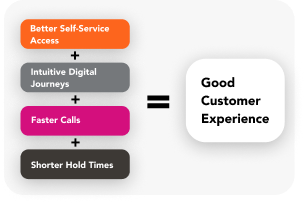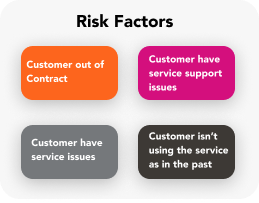 Maintaining—and growing—customer loyalty is critical in today’s highly competitive telecommunications market. Companies can no longer rely on name power or relationship length to keep subscribers locked into service or willing to upgrade products and/or plans. Those providers with the highest loyalty rates—and, consequently, the highest customer lifetime value (CLV)—all have one thing in common: excellent customer service.
Maintaining—and growing—customer loyalty is critical in today’s highly competitive telecommunications market. Companies can no longer rely on name power or relationship length to keep subscribers locked into service or willing to upgrade products and/or plans. Those providers with the highest loyalty rates—and, consequently, the highest customer lifetime value (CLV)—all have one thing in common: excellent customer service.
Considering the high cost of new customer acquisition, growing revenue through your existing customer base offers a better, faster ROI. Just how important is customer loyalty to CLV? Consider the equation: ARPU x Months = CLV. There are two ways to increase CLV. One is to increase ARPU, perhaps through upsell or cross sell, however that isn’t always possible. The other is very much within service providers’ control: increasing Months via excellent customer service that drives loyalty. Increasing Customer Loyalty equates to increased CLV.
Customer lifetime value is on the line
With more telecommunications options available, subscribers are more empowered now than ever—and more likely to defect when their voices aren’t heard. In fact, more than 80% of consumers consider alternative providers after a single bad experience. How can providers capture—and grow—customer lifetime value in today’s highly competitive market? With next-generation AI and automation tools that dial in to the three pillars of customer retention:
Cross-selling and upselling (upstream retention)
Today, multi-product customer relationships are becoming the exception, not the rule. To grow customer lifetime value, telecommunications providers must take steps to increase their “stickiness” (i.e., how indispensable a company is to a customer). These include providing premium and valued services and bundling multiple products, like cable and wireless service, that not only add convenience and value but also make customers less likely to leave.
 That’s where AI, and conversational AI in particular, comes into play. Using the data gleaned from past interactions, including behavioral, intent and even emotion data, telecoms can better match customers with the best-fitting products at the right price points. What’s more, these insights can help Sales, Marketing and Customer Service representatives tailor customer communications with the highest likelihood of converting. Conversational AI can even assist Customer Service agents with real-time upselling and cross-selling guidance during live customer interactions.
That’s where AI, and conversational AI in particular, comes into play. Using the data gleaned from past interactions, including behavioral, intent and even emotion data, telecoms can better match customers with the best-fitting products at the right price points. What’s more, these insights can help Sales, Marketing and Customer Service representatives tailor customer communications with the highest likelihood of converting. Conversational AI can even assist Customer Service agents with real-time upselling and cross-selling guidance during live customer interactions.
This approach boosts customer loyalty and “stickiness” , improving the chances of maintaining long and profitable relationships.
Customer Experience
 According to Accenture, customer experience has become the single biggest factor driving telecom customer loyalty and revenue growth. That observation is echoed in Forrester’s report, “Contact Centers are Leaving Money on the Table.” In it, Forrester outlines how providing good customer service to existing customers can drive billions in new revenue. And, as mentioned before, with the cost of acquiring new customers far outweighing the cost of retaining existing ones, companies looking to grow ROI quickly are scrambling to fix CX pain points and improve make-or-break operational metrics like AHT (Average Handle Time), FCR (First Contact Resolution) and wait times.
According to Accenture, customer experience has become the single biggest factor driving telecom customer loyalty and revenue growth. That observation is echoed in Forrester’s report, “Contact Centers are Leaving Money on the Table.” In it, Forrester outlines how providing good customer service to existing customers can drive billions in new revenue. And, as mentioned before, with the cost of acquiring new customers far outweighing the cost of retaining existing ones, companies looking to grow ROI quickly are scrambling to fix CX pain points and improve make-or-break operational metrics like AHT (Average Handle Time), FCR (First Contact Resolution) and wait times.
Proactive engagement (downstream retention)
Telecom companies often wait until it’s too late to reengage customers at risk of churning, ignoring key indicators like contract status, promotion ending, low product usage, payment delays and more. Without AI to analyze these factors and automate proactive engagement, at-risk customers defect more frequently—as much as 8x more frequently, according to one service provider.
With conversational AI-enabled engagement tools contact centers can proactively engage with customers before, during and after individual interactions. By analyzing customer data and automating outreach and follow-through actions, telecoms can drive higher customer satisfaction, trust and, consequently, downstream retention.
 For example, maybe a customer is out of contract or has had service issues or customer support issues or simply isn’t using their service as they have in the past. By identifying these (and other) risk factors, telecoms can recapture customers on the cusp of churning—and reignite their loyalty and likelihood to spend.
For example, maybe a customer is out of contract or has had service issues or customer support issues or simply isn’t using their service as they have in the past. By identifying these (and other) risk factors, telecoms can recapture customers on the cusp of churning—and reignite their loyalty and likelihood to spend.
Delivering on the three pillars of customer retention
Until now, efforts to improve upselling and cross-selling, customer experience and engagement have largely been assigned to telecom customer service staff. And the results have been haphazard at best. Addressing each of the pillars above effectively and consistently is a monumental task for human workers alone. It’s no wonder the telecommunications industry has one of the highest customer churn rates (and lowest NPS scores) in the market.
Conversational AI and automation, on the other hand, can make quick work of this difficult (not to mention costly) task. By analyzing customer experience for pain points and opportunities and guiding service reps on the best course of action—including next-best actions prompts and tips for overcoming objections—conversational AI can strengthen customer loyalty and likelihood to spend. Additionally, by automating proactive engagement tasks, such as post-interaction follow-ups and email outreach, telecoms can minimize backend frustrations that fuel customer churn.
Altogether, this multi-prong approach—upstream retention, customer experience and downstream retention—can close the loop on customer retention and help turn the tide on telecom turnover.




